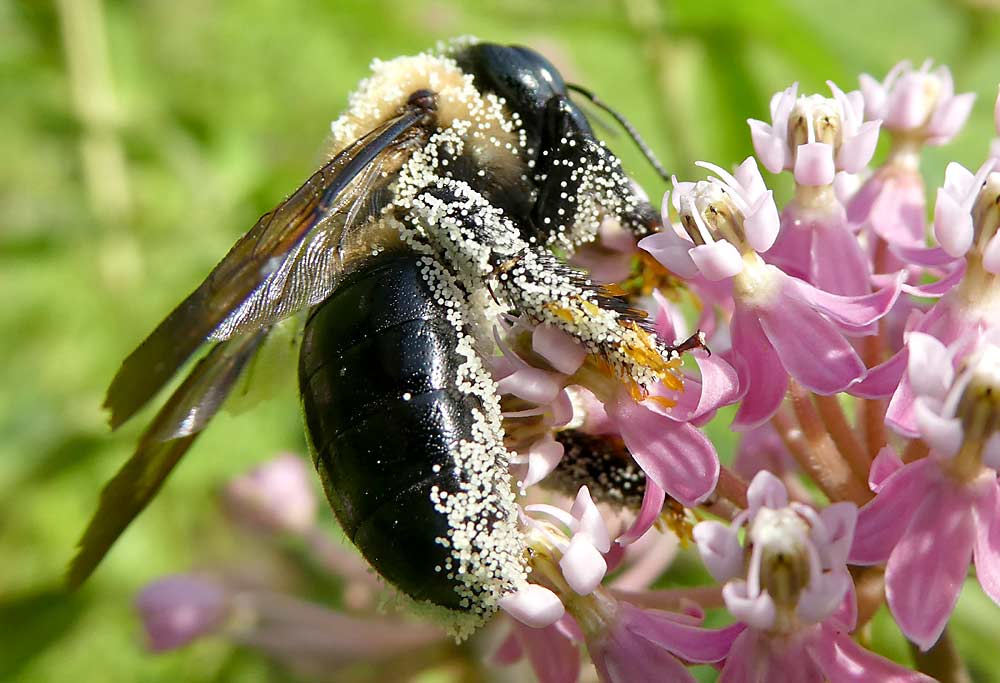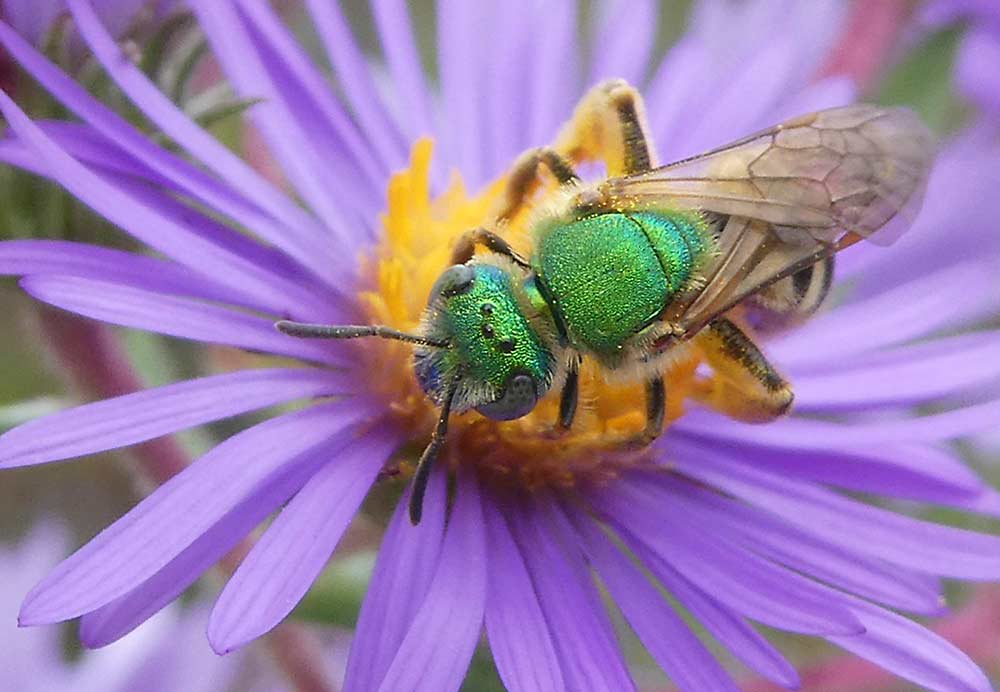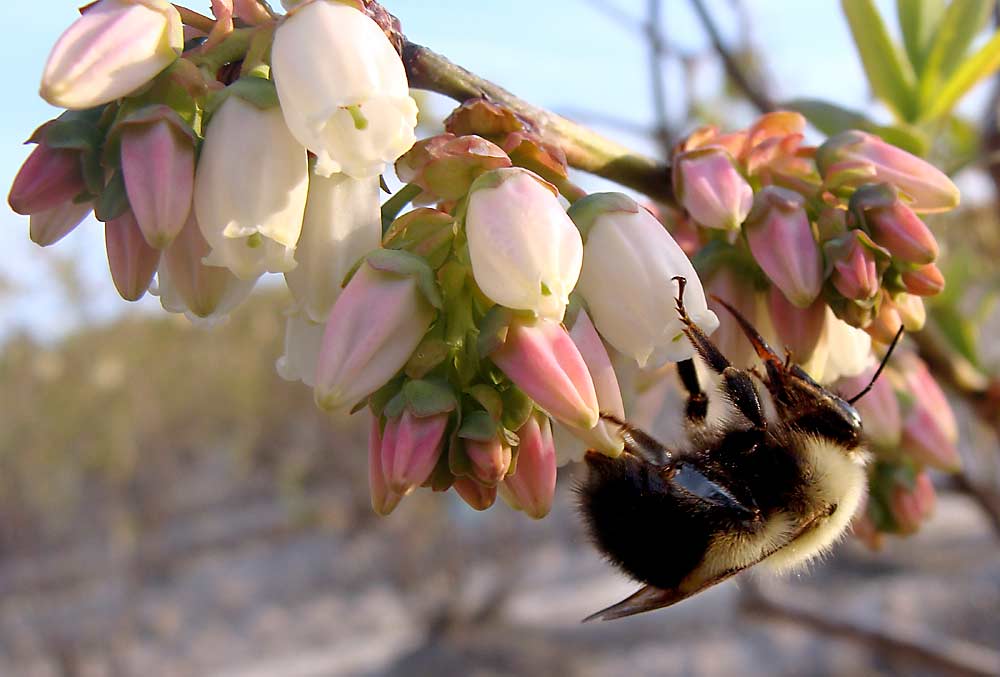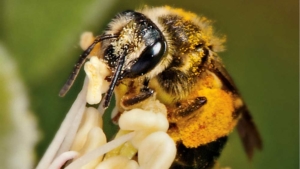
Wild bees do a lot of crop pollination, but to understand just how much they contribute and whether they can potentially do more in the future, scientists need to know far more about them.
A recent nationwide study provided part of the answer, showing that native insects provided millions of dollars’ worth of pollination services to apples, cherries and blueberries. A new U.S. initiative is now underway to help fill in some of the other major knowledge gaps. In the meantime, wild bee experts implore growers to take steps that encourage native insects, not only for the direct benefit of tree fruit orchards and blueberry fields, but also to encourage overall biodiversity and maintain healthy ecosystems.
The value of wild bees
The nationwide pollination study collected data about honey bee and wild bee visitations in apple, tart cherry and sweet cherry orchards, as well as in highbush blueberry, almond, pumpkin and watermelon production systems. Researchers found that wild pollinators made up 43.5 percent of bee visits in sweet cherry, 34.7 percent in tart cherry, 32.9 percent in apple and 8.9 percent in blueberry crops. The report also noted that in apple and tart cherry orchards, where wild bees comprised only about half as many visits as honey bees, the wild bees were more effective and deposited “an estimated 1.5 to 2 times more pollen per visit.”
The study placed annual monetary production values on the pollination services of wild bees, setting values at $1.06 billion in apples, $145 million in sweet cherries, $50 million in blueberries and $32 million in tart cherries.

A main purpose of the study was to determine whether crops are limited by pollination, or if an increase in pollination would mean more yield, according to study senior author Rachael Winfree, professor of ecology, evolution and natural resources at Rutgers University. By comparing areas with more pollinators versus those with fewer, they found greater pollination visitation “produced more blueberries, more apples and more cherries per area,” she said.
The study was unable to show exactly how much pollination limited yield, but Winfree said it still held “a big message” for the fruit-grower community, particularly farmers growing crops that bloom in the spring.
“It might be smart to increase your pollinators,” she said. “Whether that means managing habitat for native species or renting a few more honey bee hives than you usually do, that might increase yield.”
Zeroing in on wild bees
To get a better understanding of wild bees, scientists from across the country joined together in the U.S. National Native Bee Monitoring Research Coordination Network (RCN) to gather baseline data on wild bee populations. Such data is especially important now that biologists are noticing declines in wild bee populations, said Quinn McFrederick, associate professor of entomology at the University of California, Riverside. He is one of the members of the multi-organization network that kicked off in November 2020 with the help of a $380,000 grant from the U.S. Department of Agriculture.
“We haven’t documented those declines in a robust way, and we don’t know which species are declining in most cases, but among species we have looked at, it really does seem to be a perfect storm of stressors driving these declines,” McFrederick said.
Primary drivers appear to be: habitat loss due to development; climate change, including flooding, droughts and fires; disease spread through the importation of non-native pollinators; and the use of pesticides, notably neonicotinoids that “we know are really hard on wild pollinator populations,” he said.

To obtain population trend data, a main objective of the RCN is the development of standardized protocols for survey methods and data collection, “so we can start understanding trends in a better way, and also understand habitat associations and the value of pollinators to different ecosystems,” said RCN member Lora Morandin, research and conservation director of Pollinator Partnership and Pollinator Partnership Canada (sister organizations that conserve and promote pollinators and their habitats).
“It’s really about increasing the monitoring, identifying gaps where we don’t have a lot of information, identifying priority areas where we need to get more information, and bringing more people into it,” she said.
Insights from the RCN effort should be significant for fruit growers, Morandin said.
“A lot of the tree fruits and blueberries are quite reliant on pollinators for production, so having a better understanding of which pollinators are around, and how they’re responding to changes in the environment — which include reductions in habitat and changes in climate — are going to be really important for future sustainable production of these crops,” she said.
McFrederick agreed. Native bees are excellent pollinators of blueberries and spring-blooming tree fruits, so growers would do well to encourage them. That means taking measures to protect wild bees already in the crop and to invite more in, he said.
“We’d love for farmers to think about hedgerows of native plants, for example, that can provide havens for pollinators but also for other beneficial insects that can attack pest insects,” he said. “For fruit tree crops, such as apples, we have lots of native bees that are out early in the spring, so creating habitat for those bees can not only bring in those pollinators, but can also bring other beneficial insects in.” He wants to see growers provide more diversified landscapes around their orchards and blueberry fields.
“When you’re benefitting the native pollinators, you’re actually benefitting your crop as well, so I’d just like people to think about that,” McFrederick said.
—by Leslie Mertz







Leave A Comment